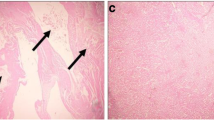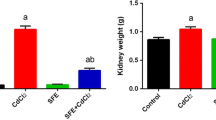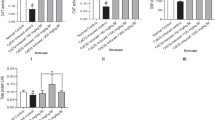Abstract
Cadmium (Cd), as a toxic metal, can accumulate in kidneys and induce renal failure. This study was undertaken to evaluate the protective effects of Allium hirtifolium Boiss bulbs against Cd-induced renal failure in rats. Thirty-six rats were divided into 6 groups: group 1, 2, and 3 received vehicle, Cd (100 mg/L/day by drinking water), and AhB extract (200 mg/kg/day; orally), respectively. Groups 4, 5, and 6 were Cd groups which treated AhB extract (50, 100, and 200 mg/kg/day, respectively). After 2 weeks, renal function and oxidative stress markers were determined by using colorimetric methods. Our findings showed that Cd caused a significant increase in creatinine (Cr; p<0.05), uric acid (p<0.01), BUN (p<0.05), serum levels, lipid peroxidation (LPO; p<0.01), and nitric oxide (NO; p<0.01); the depletion of the total antioxidant capacity (TAC; p<0.01) and total thiol molecules (TTM; p<0.001); and structural alterations in the renal tissue. Following AhB extract administration, a remarkable improvement was observed in the functional and oxidative stress markers of renal tissue.
This study suggests that AhB may prevent progression of Cd-induced renal failure via improvement of oxidative/antioxidant balance in renal tissue.



Similar content being viewed by others
References
Adaramoye OA, Akanni OO (2016) Modulatory effects of methanol extract of Artocarpus altilis (Moraceae) on cadmium-induced hepatic and renal toxicity in male Wistar rats. Pathophysiology 23(1):1–9
Adeline J, Josiane A, Isabelle HF, Florence HP, Karine C, Marine L, Frédéric L, Fayçal O, Eric F, Jean-Marc M (2018) Impact of chronic and low cadmium exposure of rats: sex specific disruption of glucose metabolism. Chemosphere 207:764–773
Aghababaei R, Javadi I, Nili-Ahmadabadi A, Parsafar S, Ahmadimoghaddam D (2018) Occurrence of bacterial and toxic metals contamination in illegal opioid-like drugs in Iran: a significant health challenge in drug abusers. Daru 26(1):77–83
Amidi N, Moradkhani S, Sedaghat M, Khiripour N, Larki-Harchegani A, Zadkhosh N, Mirhoseini M, Ranjbar A (2015) Effect of green tea on inflammation and oxidative stress in cisplatin-induced experimental liver function. J HerbMed Pharmacol 5(3):99–102
Asgarpanah J, Ghanizadeh B (2012) Pharmacologic and medicinal properties of Allium hirtifolium Boiss. Afr J Pharm Pharmacol 6(25):1809–1814
Azadi HG, Ghaffari SM, Riazi GH, Ahmadian S, Vahedi F (2008) Antiproliferative activity of chloroformic extract of Persian shallot, Allium hirtifolium, on tumor cell lines. Cytotechnology 56(3):179–185
Chen Q, Zhang R, Li WM, Niu YJ, Guo HC, Liu XH, Hou YC, Zhao LJ (2013) The protective effect of grape seed procyanidin extract against cadmium-induced renal oxidative damage in mice. Environ Toxicol Pharmacol 36(3):759–768
Chen S, Liu G, Long M, Zou H, Cui H (2018) Alpha lipoic acid attenuates cadmium-induced nephrotoxicity via the mitochondrial apoptotic pathways in rat. J Inorg Biochem 184:19–26
Chunhabundit R (2016) Cadmium exposure and potential health risk from foods in contaminated area, Thailand. Toxicol Res 32(1):65–72
Claudio SR, Gollucke APB, Yamamura H, Morais DR, Bataglion GA, Eberlin MN, Peres RC, Oshima CTF, Ribeiro DA (2016) Purple carrot extract protects against cadmium intoxication in multiple organs of rats: genotoxicity, oxidative stress and tissue morphology analyses. J Trace Elem Med Biol 33:37–47
Dkhil MA, Al-Quraishy S, Diab MM, Othman MS, Aref AM, Moneim AEA (2014) The potential protective role of Physalis peruviana L. fruit in cadmium-induced hepatotoxicity and nephrotoxicity. Food Chem Toxicol 74:98–106
Elkhadragy MF, Al-Olayan EM, Al-Amiery AA, Moneim AEA (2018) Protective effects of Fragaria ananassa extract against cadmium chloride-induced acute renal toxicity in rats. Biol Trace Elem Res 181(2):378–387
Famurewa AC, Ejezie AJ, Ugwu-Ejezie CS, Ikekpeazu EJ, Ejezie FE (2018) Antioxidant and anti-inflammatory mechanisms of polyphenols isolated from virgin coconut oil attenuate cadmium-induced oxidative stress-mediated nephrotoxicity and inflammation in rats. J Appl Biomed 16:281–288. https://doi.org/10.1016/j.jab.2018.02.003
Ghahremani-Majd H, Dashti F, Dastan D, Mumivand H, Hadian J, Esna-Ashari M (2012) Antioxidant and antimicrobial activities of Iranian mooseer (Allium hirtifolium Boiss) populations. Hortic Environ Biotechnol 53(2):116–122
Hagar H, Al Malki W (2014) Betaine supplementation protects against renal injury induced by cadmium intoxication in rats: role of oxidative stress and caspase-3. Environ Toxicol Pharmacol 37(2):803–811
Hajian N, Rezayatmand Z, Shahanipur K (2018) Preventive effects of Allium hirtifolium Boiss methanolic and aqueous extracts on renal injury induced by lead in rats. J Herbmed Pharmacol 7(3):155–159
Harchegani AL, Hemmati AA, Nili-Ahmadabadi A, Darabi B, Shabib S (2017) Cromolyn sodium attenuates paraquat-induced lung injury by modulation of proinflammatory cytokines. Drug Res 67(05):283–288
Hassani S, Maqbool F, Salek-Maghsoudi A, Rahmani S, Shadboorestan A, Nili-Ahmadabadi A, Amini M, Norouzi P, Abdollahi M (2018) Alteration of hepatocellular antioxidant gene expression pattern and biomarkers of oxidative damage in diazinon-induced acute toxicity in Wistar rat: a time-course mechanistic study. EXCLI J 17:57–71
Jafarian A, Ghannadi A, Elyasi A (2010) The effects of Allium hirtifolium Boiss. On cell-mediated immune response in mice. Iranian. J Pharm Res 2:51–55
Kim KS, Lim HJ, Lim JS, Son JY, Lee J, Lee BM, Chang SC, Kim HS (2018) Curcumin ameliorates cadmium-induced nephrotoxicity in Sprague-Dawley rats. Food Chem Toxicol 114:34–40
Korkmaz A, Kolankaya D (2013) Inhibiting inducible nitric oxide synthase with rutin reduces renal ischemia/reperfusion injury. Can J Surg 56(1):6–14
Lai JH, Luo SF, Hung LF, Huang CY, Lien SB, Lin LC, Liu FC, Yen BL, Ho LJ (2017) Physiological concentrations of soluble uric acid are chondroprotective and anti-inflammatory. Sci Rep 7:2359. https://doi.org/10.1038/s41598-017-02640-0
Leelarungrayub N, Rattanapanone V, Chanarat N, Gebicki JM (2006) Quantitative evaluation of the antioxidant properties of garlic and shallot preparations. Nutrition 22(3):266–274
Liu J, Qu W, Kadiiska MB (2009) Role of oxidative stress in cadmium toxicity and carcinogenesis. Toxicol Appl Pharmacol 238(3):209–214
Miltonprabu S, Sumedha N, Senthilraja P (2017) Diallyl trisulfide, a garlic polysulfide protects against as-induced renal oxidative nephrotoxicity, apoptosis and inflammation in rats by activating the Nrf2/ARE signaling pathway. Int Immunopharmacol 50:107–120
Mohammadi-Motlagh HR, Mostafaie A, Mansouri K (2011) Anticancer and anti-inflammatory activities of shallot. Arch Med Sci 7(1):38–44
Nili-Ahmadabadi A, Sedaghat M, Ranjbar A, Poorolajal J, Nasiripour H, Nili-Ahmadabadi M (2016) Quantitative analysis and health risk assessment of methanol in medicinal herbal drinks marketed in Hamadan, Iran. J App Pharm Sci 6(7):049–052
Nili-Ahmadabadi A, Ali-Heidar F, Ranjbar A, Mousavi L, Ahmadimoghaddam D, Larki-Harchegani A, Ghafouri-Khosrowshahi A (2018) Protective effect of amlodipine on diazinon-induced changes on oxidative/antioxidant balance in rat hippocampus. Res Pharm Sci 13(4):368–376
Pandya D, Nagrajappa AK, Ravi KS (2016) Assessment and correlation of urea and creatinine levels in saliva and serum of patients with chronic kidney disease, diabetes and hypertension—a research study. J Clin Diagn Res 10(10):ZC58–ZC62
Prozialeck WC, Edwards JR (2012) Mechanisms of cadmium-induced proximal tubule injury: new insights with implications for biomonitoring and therapeutic interventions. J Pharmacol Exp Ther 343(1):2–12
Rahimifard M, Navaei-Nigjeh M, Mahroui N, Mirzaei S, Siahpoosh Z, Nili-Ahmadabadi A, Mohammadirad A, Baeeri M, Hajiaghaie R, Abdollahi M (2014) Improvement in the function of isolated rat pancreatic islets through reduction of oxidative stress using traditional Iranian medicine. Cell J 16(2):147–163
Satarug S, Vesey DA, Gobe GC (2017) Health risk assessment of dietary cadmium intake: do current guidelines indicate how much is safe? Environ Health Perspect 125(3):284–288
Teo SH, Endre ZH (2017) Biomarkers in acute kidney injury (AKI). Best Pract Res Clin Anaesthesiol 31(3):331–344
Wongmekiat O, Leelarugrayub N, Thamprasert K (2008) Beneficial effect of shallot (Allium ascalonicum L.) extract on cyclosporine nephrotoxicity in rats. Food Chem Toxicol 46(5):1844–1850
Wunnapuk K, Liu X, Peake P, Gobe G, Endre Z, Grice JE, Roberts MS, Buckley NA (2013) Renal biomarkers predict nephrotoxicity after paraquat. Toxicol Lett 222(3):280–288
Zeinvand-Lorestani H, Nili-Ahmadabadi A, Balak F, Hasanzadeh G, Sabzevari O (2018) Protective role of thymoquinone against paraquat-induced hepatotoxicity in mice. Pestic Biochem Physiol 148:16–21
Acknowledgements
Financial support for this work was provided by vice-chancellor for research and technology, Hamadan University of Medical Sciences, Hamadan, Iran (Grant No. 9412257444).
Author information
Authors and Affiliations
Corresponding author
Ethics declarations
Conflict of interest
The authors declare that they have no conflict of interest.
Additional information
Responsible editor: Philippe Garrigues
Publisher’s note
Springer Nature remains neutral with regard to jurisdictional claims in published maps and institutional affiliations.
Rights and permissions
About this article
Cite this article
Dastan, D., Karimi, S., Larki-Harchegani, A. et al. Protective effects of Allium hirtifolium Boiss extract on cadmium-induced renal failure in rats. Environ Sci Pollut Res 26, 18886–18892 (2019). https://doi.org/10.1007/s11356-019-04656-7
Received:
Accepted:
Published:
Issue Date:
DOI: https://doi.org/10.1007/s11356-019-04656-7




